These Fall Flowers Will Add Pops of Color to Your Garden

"Hearst Magazines and Yahoo may earn commission or revenue on some items through these links."
When the air gets chillier and the leaves turn red and orange, don’t start packing away your gardening gloves. The summer might be over, but that doesn’t mean you have to say goodbye to gorgeous blooms. Fall flowers brighten up your garden and yard during the cooler months, adding bursts of color all season long.
The key to having a vibrant garden in autumn is to plant flowers that can handle colder temperatures, require less sunlight, and are frost-tolerant. From camellias to daisies to asters to petunias, some of your favorite plants make the list of the best fall flowers. Though, some are better suited for fall than other seasons because they respond well to the lower temperatures and different durations of light that autumn usually brings.
Both perennial flowers and annual flowers make for great additions to a cool-weather garden. In fact, there are plenty that you can start planting in the summer for vibrant blooms that last through fall and into winter’s first frost. Not all fall flowers need to fit these criteria, though. Autumn looks and feels drastically different in Northern and Southern states—think of Maine versus Florida in October. What may be considered a fall flower in one environment may not thrive in another, so be sure to consult the USDA’s plant hardiness zones to check when to plant specific flowers based on your area’s climate.
Now, grab your gardening tools and read on for the best fall flowers, according to gardening experts.
Camellia
Camellias are as beautiful as their name. They bloom from May all the way to October and grow best in USDA zones seven to 10. “Camellia is sometimes called the rose of winter, because of its striking resemblance to the beloved rose,” says Maureen Wright, horticultural sales consultant at Fast Growing Trees. “These beauties can bloom in three seasons and put on a colorful show in the fall landscape.” Wright recommends planting camellias in a spot where they’ll receive morning sun and afternoon shade with well-draining soil. If you consistently water them and use fertilizer for acid-loving plants, these flowers are sure to blossom wonderfully.
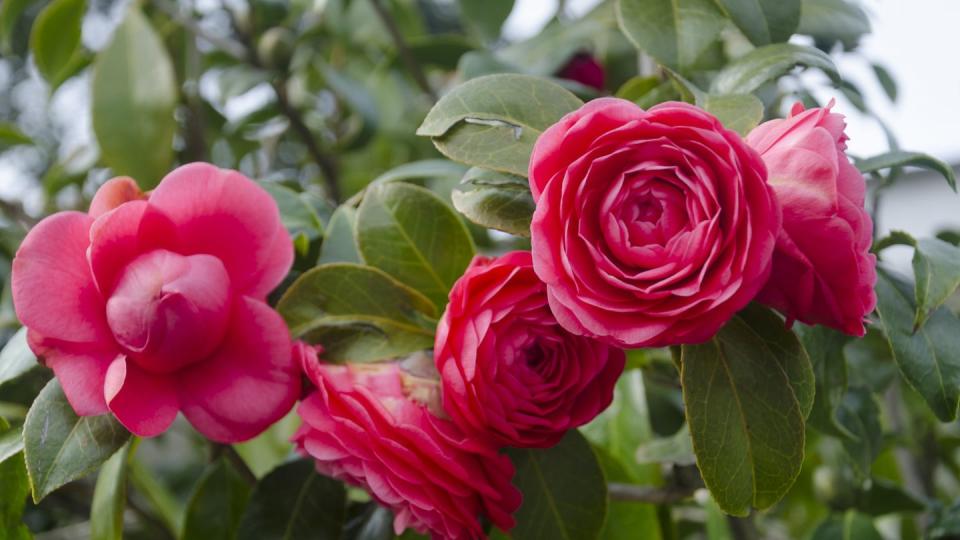
Autumn Joy Sedum
For a flower that comes back every year and lasts through the fall, Autumn Joy Sedum is a colorful pick. “Sedum is a category of tough, easygoing perennials that you can step on and they will still grow,” says Dan Stuppiello, divisional merchandise manager of Live Goods at Home Depot. Stuppiello says the Autumn Joy cultivar is easy to grow in well-draining soil and full- to partial-sun and thrives best in USDA cold hardiness zones three to nine. These flowers are bright pink in the summer and transform into a copper color in the fall, but their hue isn’t the only beautiful thing about them. “Autumn Joy sedum is one of the few nectar-producing flowers in late summer and early fall that feed butterflies, bees, and other pollinators,” Wright says. “They will even attract late-migrating hummingbirds.”
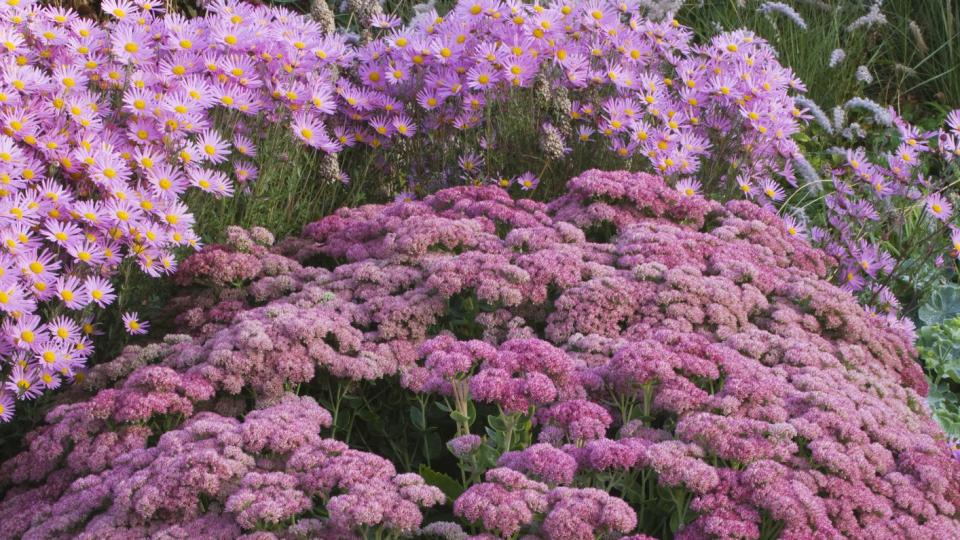
Echinacea (coneflower)
These perennial flowers have rosy-purple petals with a large, cone-shaped pistil that attracts hummingbirds, butterflies, and bees. “[They are] excellent for massing in borders or mixed into meadow and wildflower gardens,” Stuppiello says. “[They] will also perform in the dappled shade of woodland garden edges.” Blooming from early summer through autumn, Echinaceas are commonly used as an herbal remedy in tea. They have a hardy zone of four to nine and grow best with partial shade and sun.
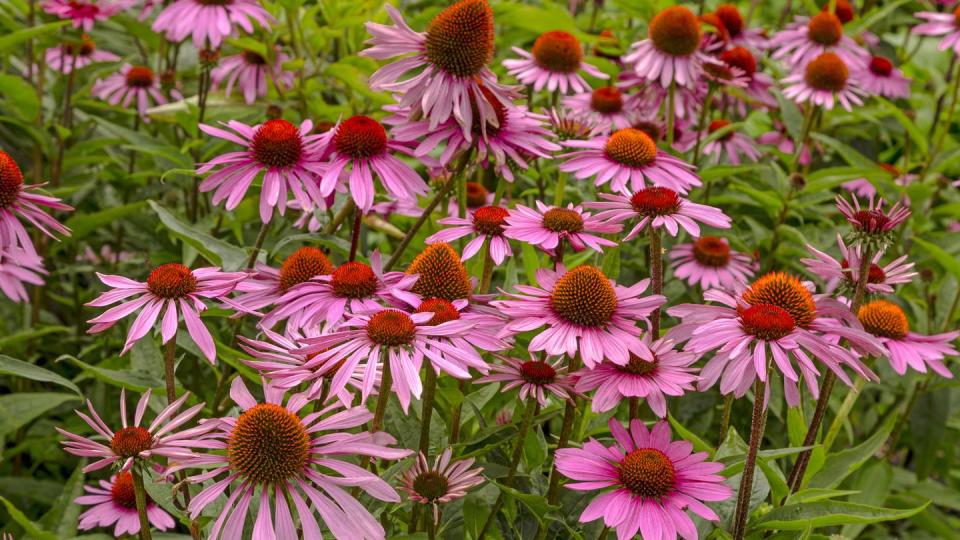
Hydrangea
Hydrangeas are big cone-shaped flowers often seen in large shrubs. They darken in color as the nighttime temperatures cool down, transforming from a bright white to pink to a deeper red in the fall depending on the variety. “It’s a larger shrub, so it makes a great focal point, border planting, or privacy hedge,” says Ryan McEnaney, author of Field Guide to Outside Style, and spokesperson for Endless Summer Hydrangeas and First Editions Shrubs & Trees, who recommends the Berry White panicle Hydrangeas. “Panicle hydrangeas bloom every year on the current season’s growth, so it’s really easy to maintain and get flowers. To encourage strong stems and lots of branching, cut Berry White back by one-third to one-half of its size in late winter.”
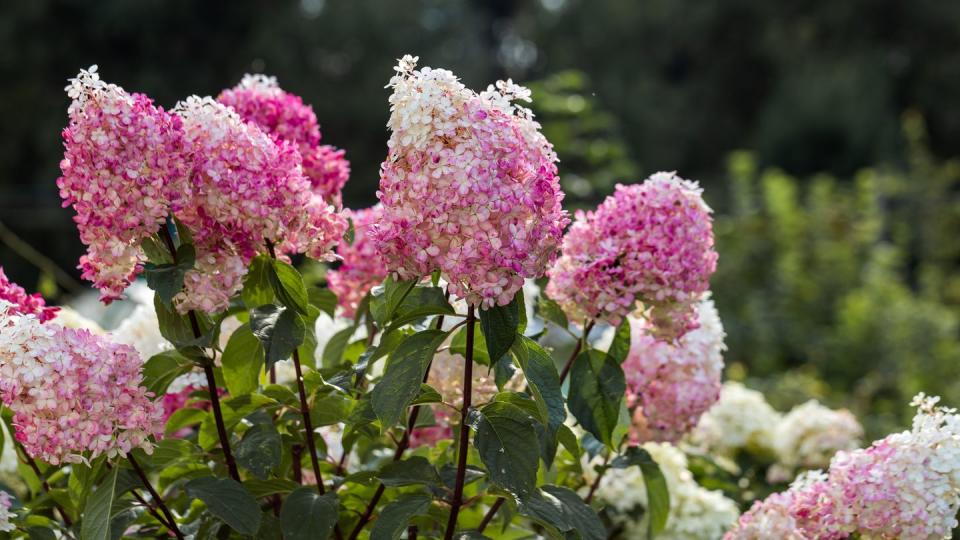
Aster
Aster flowers are planted in the spring and bloom in the fall, revealing shades of purple and pink in your garden as your summer flowers begin to fade. They are star-like wildflowers, similar in appearance to daisies, and can grow freely in open, sunny areas. “Aster can be moisture sensitive, so we recommend trying different watering methods to get the most out of your flower garden blooms,” Stuppiello says. “These flowers require more water in the heat of summer, and less when temperatures cool down.” Aster grows best in USDA zones four to eight and can return the following year if you plant them ahead of the first hard freeze.
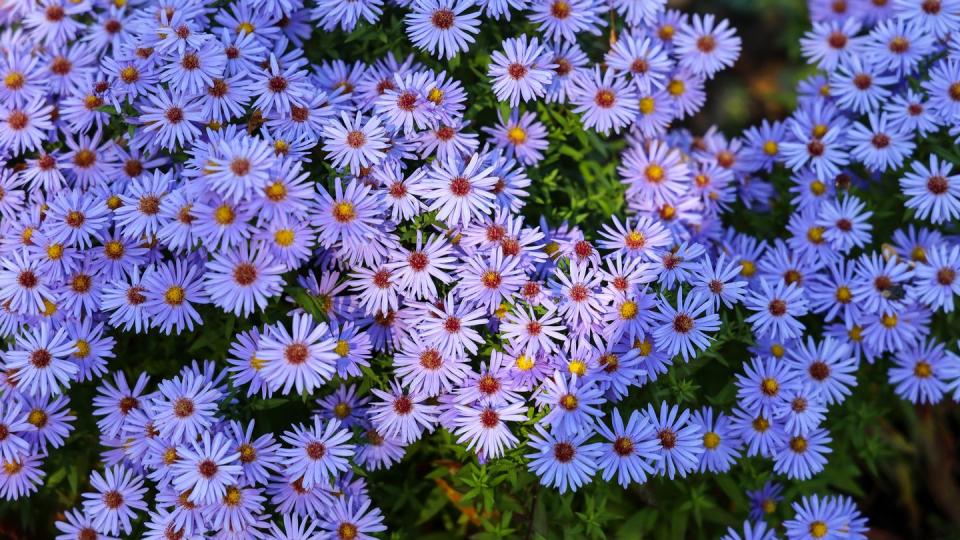
Chrysanthemum (mums)
These perennial flowers are an autumn garden classic for USDA zones five to nine. Colder fall days promote flowering for mums, so they add a pop of color and vibrancy to an otherwise fading garden in the fall. “They thrive in cooler temperatures and coincide with autumn foliage changes and harvest time,” Wright says. Choose from a range of yellows and reds, consistently water them, and plant the seeds in a sunny area to let them thrive. If you live in an area with colder winters, Wright recommends you “cut back the stems to about 3- to 4-in above ground level. Mulch the base of the plants with a layer of pine straw or leaves to insulate them.”
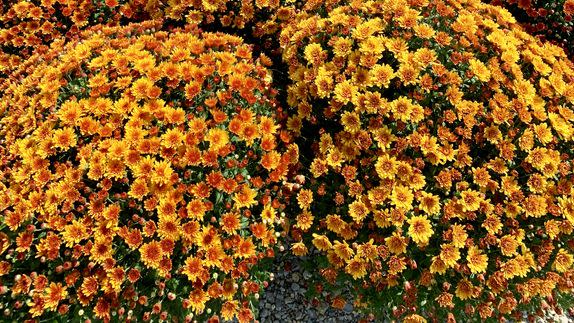
Shasta Daisy
The shasta daisy is a perennial that thrives in USDA zones five to nine and can tolerate colder temperatures and droughts. Stuppiello says daisies spread easily, so you can grow them in long flower beds or along fences. Just make sure they’re planted in full sunlight, and these little blooms can add some liveliness to an autumn garden. “This hardy, sun-loving flower plays well in your garden with companions like daylilies, rudbeckia, and ornamental grasses,” Stuppiello says.
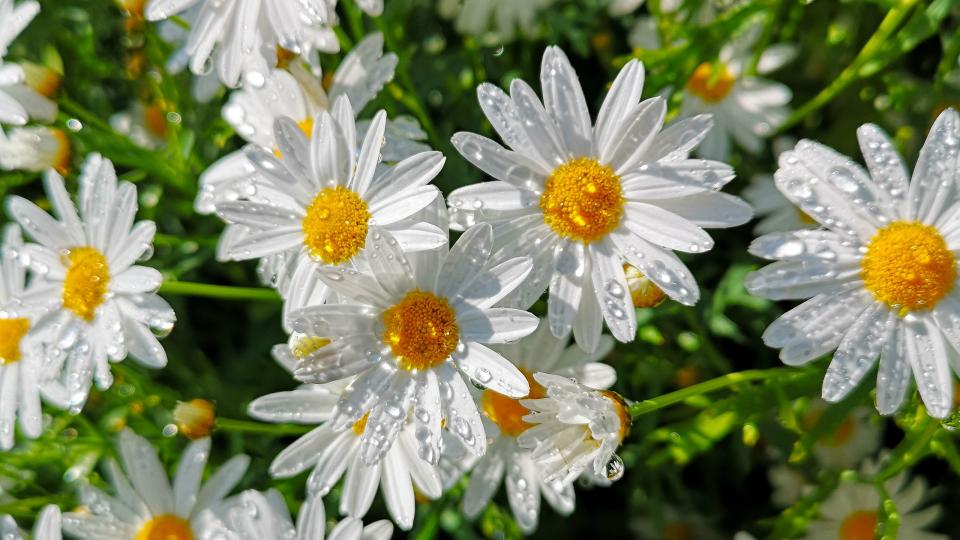
Dogwood
If you get bored of the same old plant in your garden all year long, you’ll love this shrub’s color transformations through summer and into fall. “Early in the season, the leaves emerge with a bronze tinge before brightening up to chartreuse for the summer,” McEnaney says. “In fall the leaves turn a rainbow of purple, red, yellow, and orange before the leaves drop and show off the dogwood’s famous red stems in winter.” He recommends the Neon Burst Dogwood from Bailey Nurseries, and it grows well in most environments, thriving in USDA zones two to nine and adapting to almost all soils.
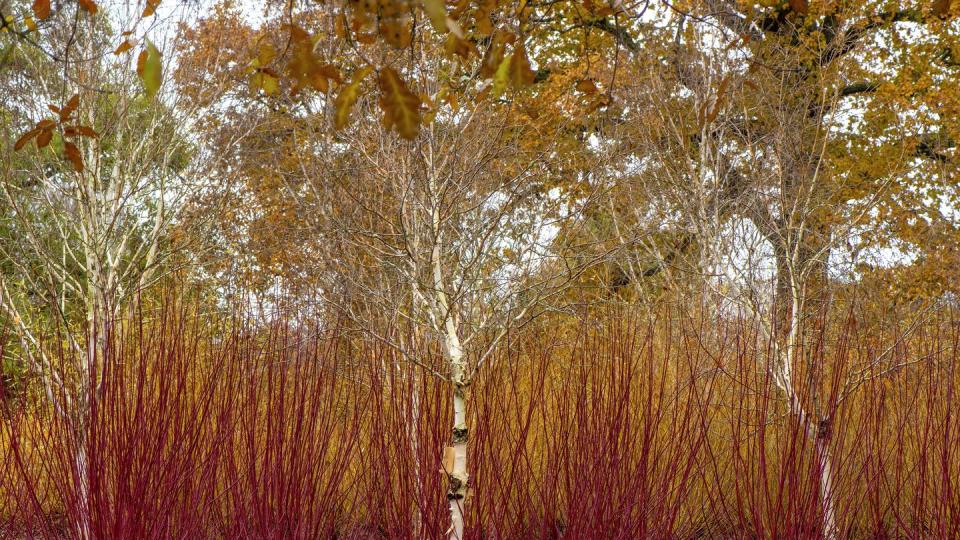
Allium
These perennial flowers look like they’re straight out of The Lorax with long stems and colorful bulbs. Stuppiello recommends these for an autumn garden and says the globe-shaped blooms will last from spring to autumn, and they can withstand USDA hardiness zones four and up.

Tea Olive Tree
Add a fresh, sweet fragrance to your outdoor patio in the summer and living room in the colder months with this sweet-smelling plant. Tea olive trees are dense shrubs and look similar to holly leaves. Wright says they’re typically found in Southern gardens, low-maintenance, can grow in partial shade, and grow best in zones seven to 10.
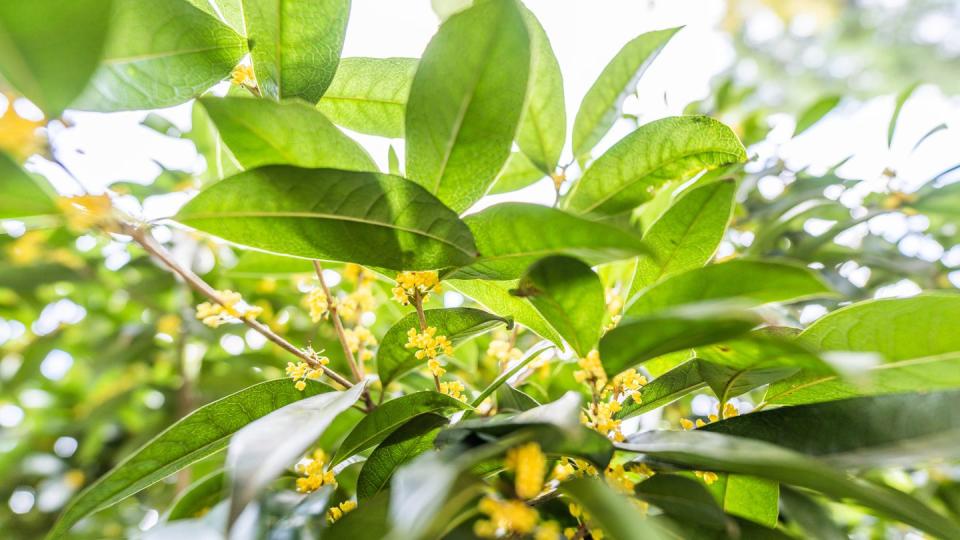
Hypericum
Shrubs are perfect for filling space in a yard or garden, and Hypericum adds a pop of color. In the fall, its green leaves turn shades of red, yellow, and orange for the perfect autumn color palette. Even the texture of the plant changes as the leaves transform. “I especially love this plant because it provides a different textured leaf in the garden, requires little maintenance to keep its mounded shape, tolerates salt spray for those with extreme winter climates, and is deer-resistant,” McEnaney says. This flower thrives in USDA hardiness zones four to seven, can grow in partial shade, and needs watering.
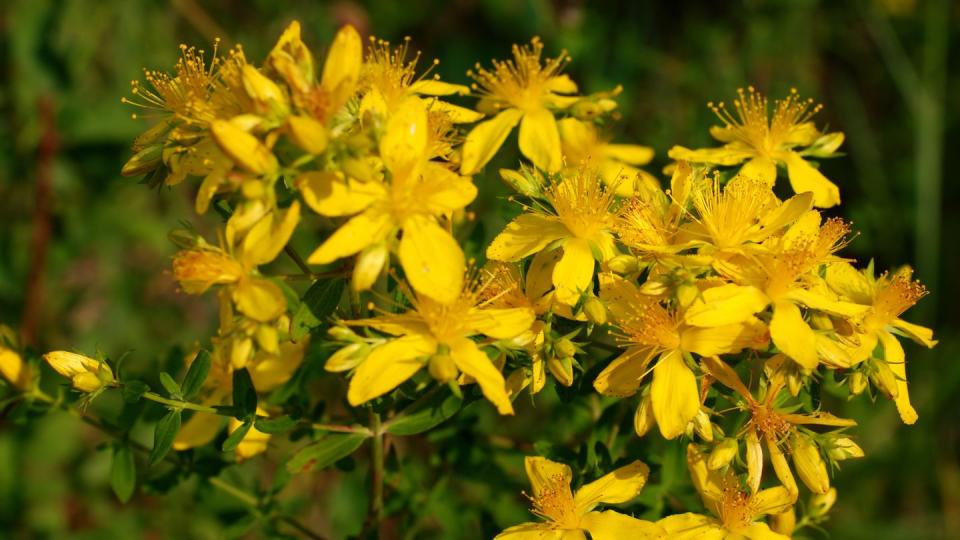
Gaillardia (Blanket flower)
If you love daisies in the summertime, you’ll love this autumn version with red, orange, and yellow colored petals. It is a perennial flower and Stuppiello says it boasts a long blooming season, just make sure it’s planted in a well-draining soil, covered in mulch, and water it often.
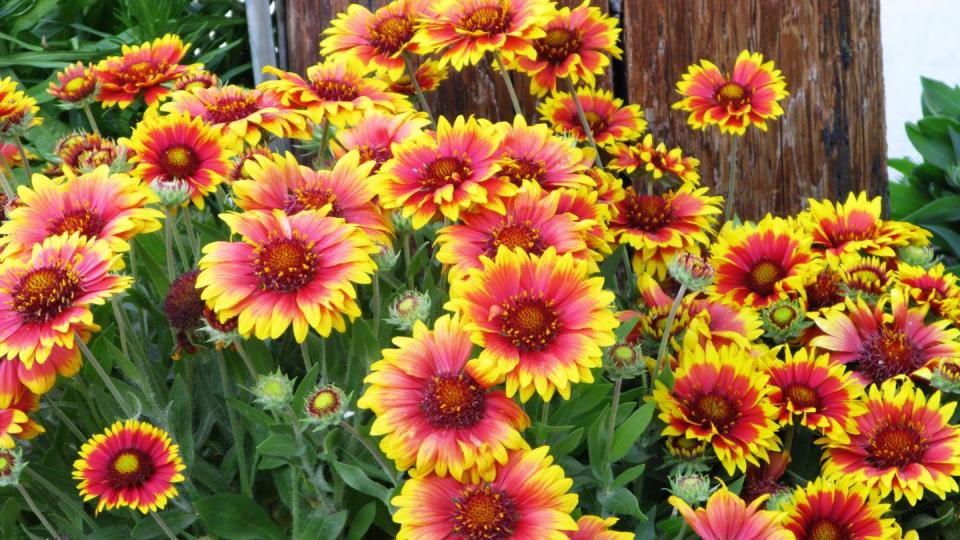
Pink Muhly Grass
If pink is your favorite color, you’re in luck with these large plants that add a sea of it to any yard. “Pink muhly grass creates a stunning burst of color in the late season, making it an excellent addition to gardens or landscapes that may need a boost of visual interest during the fall,” Wright says. They grow best in USDA zones five to 10 with sandy soil and are low-maintenance with little watering required. “Although it is drought tolerant, during times of prolonged dry weather it is important to make sure it receives an inch of deep watering during those times,” Wright says.
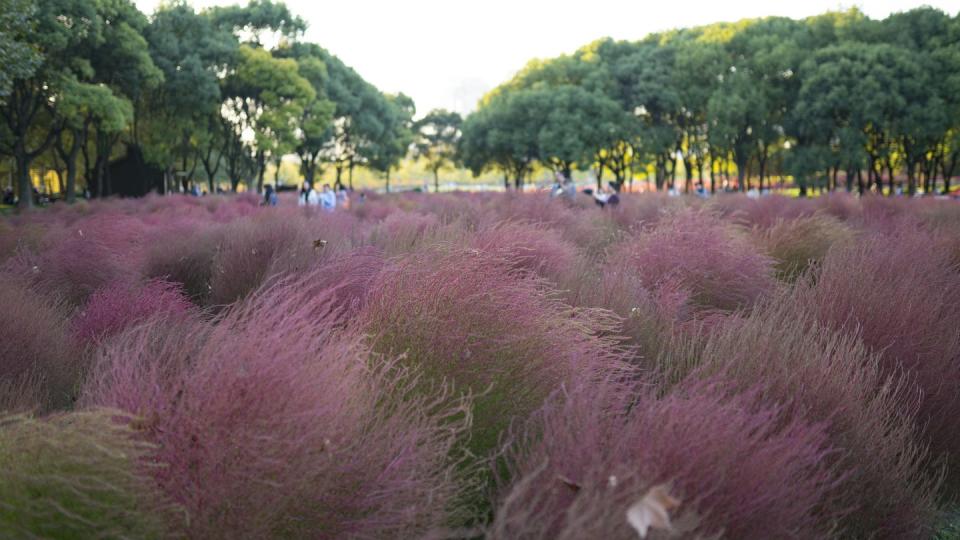
Phlox Paniculata
This dainty flower with purple or pink petals is easy to grow and thrives in the late summer and into fall. It grows best in USDA zones four to eight, in full sunlight, and in most soils. “Keep phlox watered during hot spells, and if you live in an area with high humidity, you may spot powdery mildew,” Stuppiello says. “To prevent this, look for mildew-resistant cultivars and give them room for air circulation.”
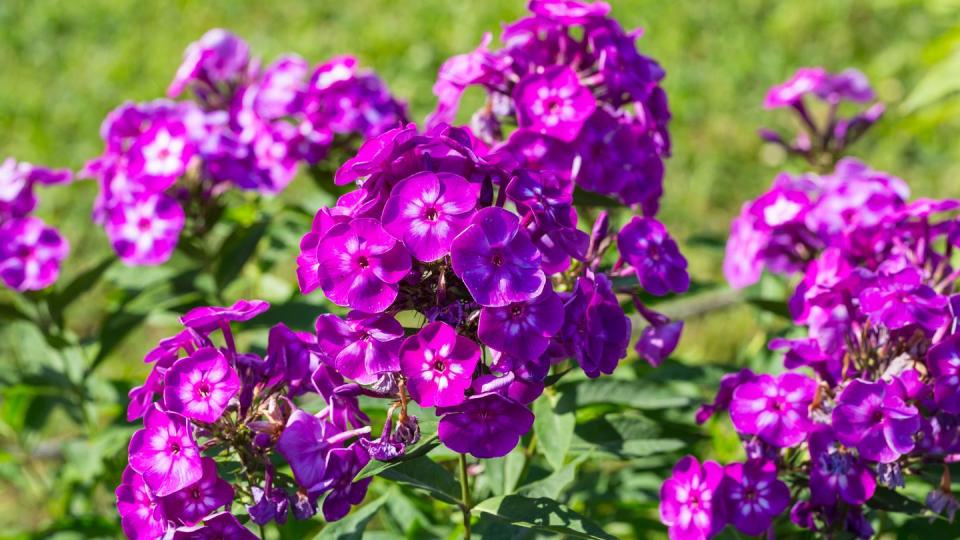
Ninebark
McEnaney recommends this plant for an autumn garden because it blooms in the fall with vibrant shades of red and orange. This large shrub can thrive in most environments, surviving in USDA zones two to eight and most soils—but it loves full sunshine. Surprise your friends and neighbors with McEnaney’s fun fact about Amber Jubilee, which “was named in honor of Queen Elizabeth’s Jubilee anniversary and she planted a shrub while visiting Canada.”
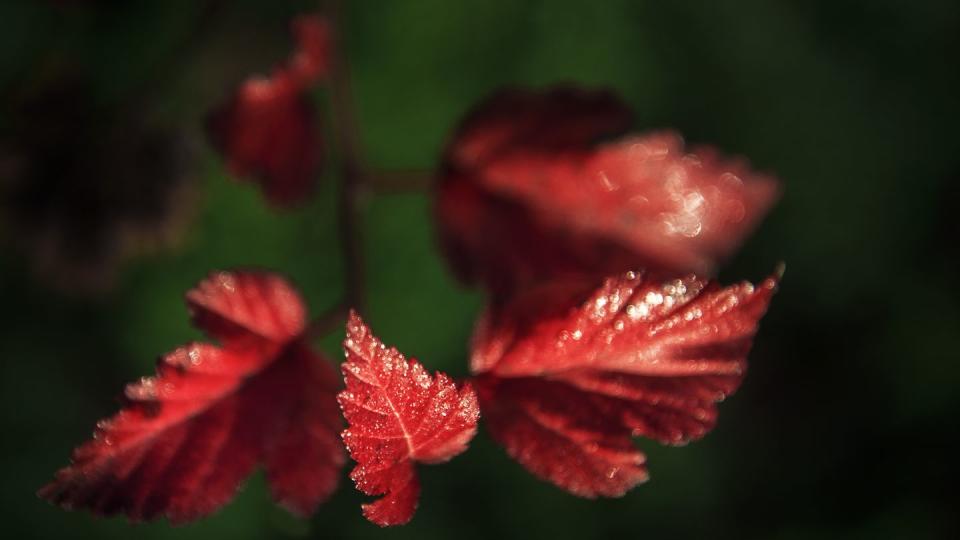
Salvia
Not only do these perennial flowers add a pop of purple and blue to your fall garden, but Stuppiello says they attract hummingbirds and butterflies in late summer. They bloom in USDA zones three to nine, and can grow in partial sun or light shade. Salvia is a great fall flower because it can survive drought and frost up to -20 degrees, allowing them to blossom into the early winter.
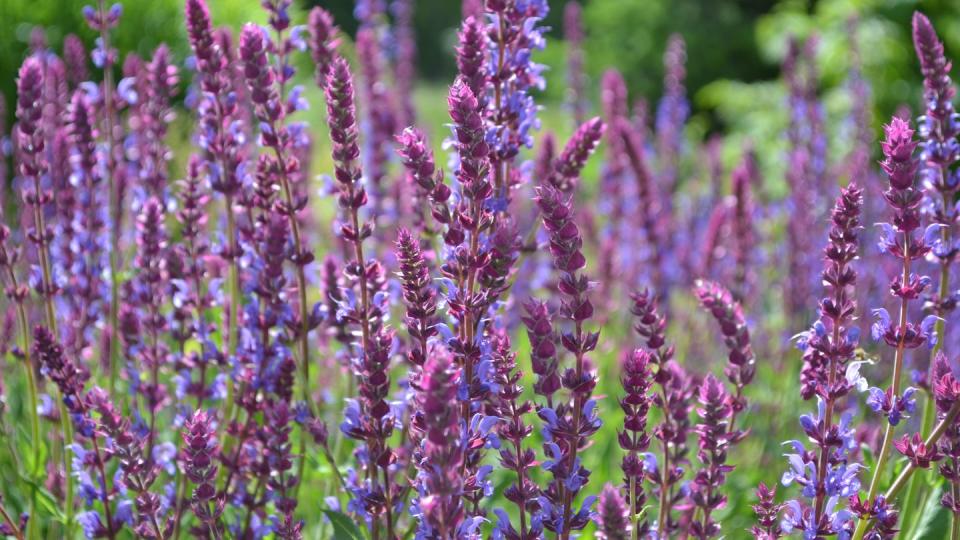
Russian Sage
Russian sage is a perennial plant with blue and purple flowers that blooms until October. “Cut back Russian sage in late winter or early spring to encourage summer and fall blooming,” Wright says. “You can prune out dead growth anytime throughout the year, as necessary.” It can tolerate droughts and withstand autumn temperatures, but it needs full sunlight to truly thrive. It grows in zones four to nine, and is a large plant that’s perfect for filling in empty yard space.
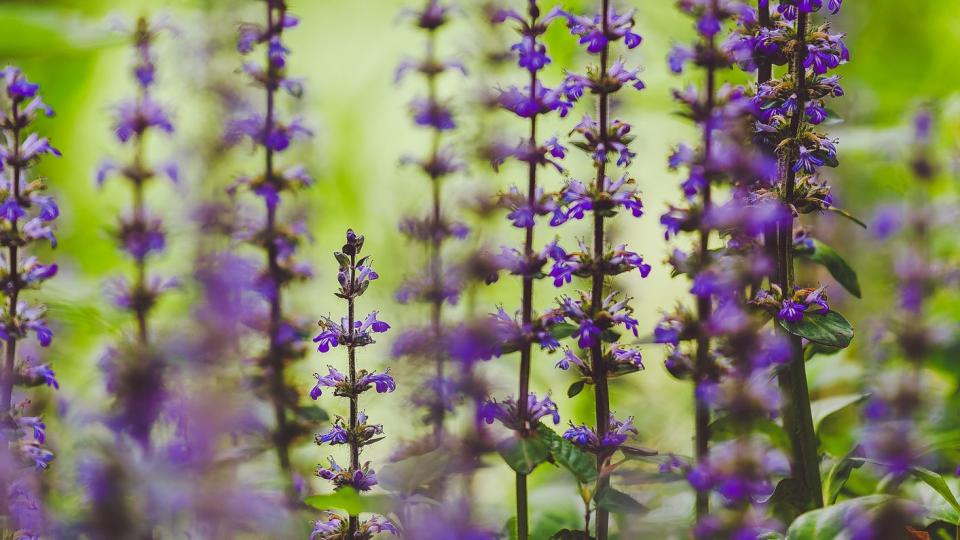
Bluebeard
“Sapphire Surf Bluebeard is a great shrub to break up the orange and red tones of the fall landscape with its vibrant blue blooms late in the season,” McEnaney says. This shrub grows in USDA zones five to nine, is drought tolerant, and is simple to maintain, just make sure to water regularly and plant it in a sunny spot. This flower can be planted in smaller spots in a garden among other flowers as it only grows around two feet tall and three feet wide.
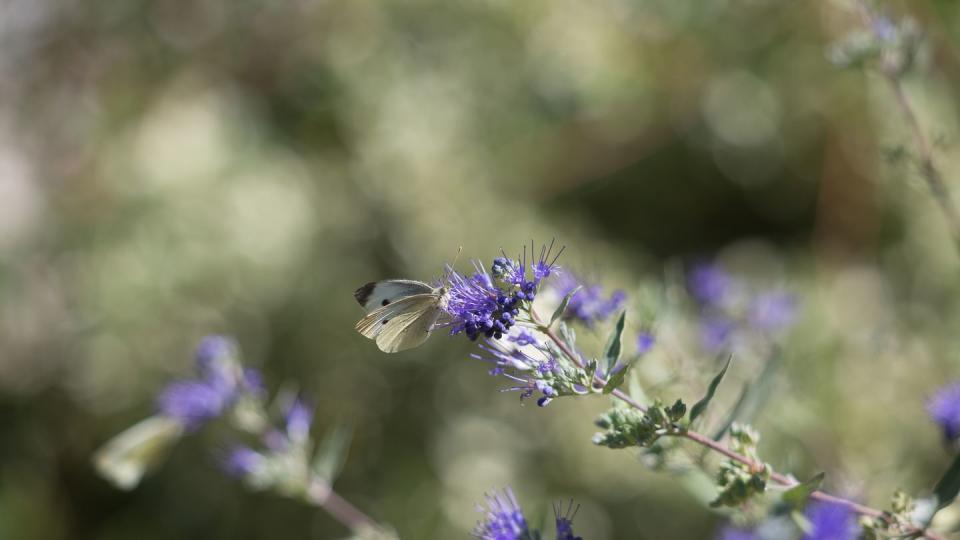
Rudbeckia
You may know this flower for its bright yellow petals and popular nickname, Black-eyed Susan. Rudbeckia are perennial flowers that can bloom through the summer into fall in USDA zones three to nine. Stuppiello says it is, “a terrific choice for borders, mass plantings, cutting gardens, and containers that combine especially well with ornamental grasses.” When the flowers die at the end of autumn, its seeds will once again germinate and sprout in the spring, giving you bright flowers every summer and fall.
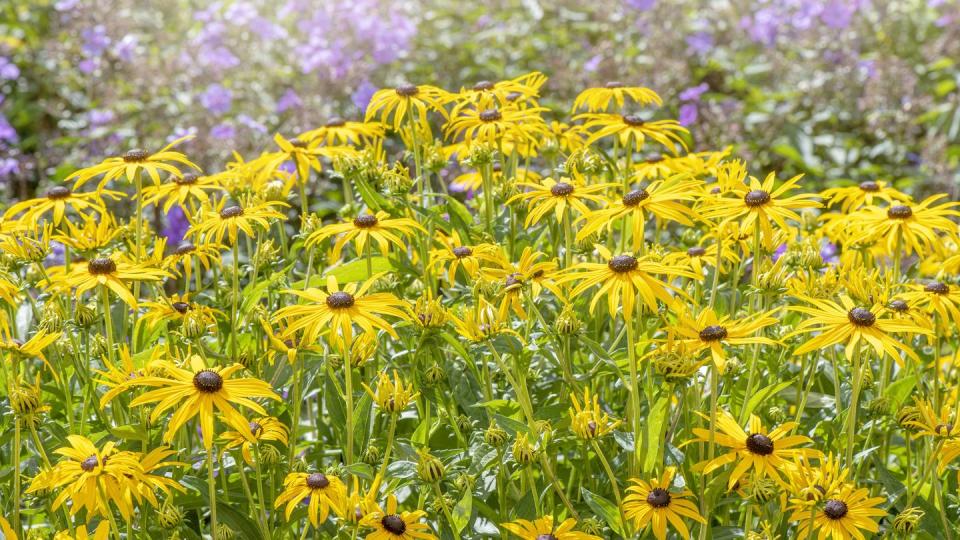
Autumn Cherry
Enjoy the beautiful scent and appearance of this tree that blooms with pastel pink flowers every spring and fall. While autumn cherry trees are relatively low-maintenance, it is necessary to properly water them. “Too much water can cause the tree to have yellowing leaves that fall off and cause potential problems with root disease,” Wright says. “Depending on the region you live in and weather conditions, you want to make sure that the tree is getting the proper amount of water. The best way to do this is to feel the soil and check for consistent moisture about 3-in down.” These trees grow in USDA zones five to eight, adapt to most soils, and can tolerate partial shade.
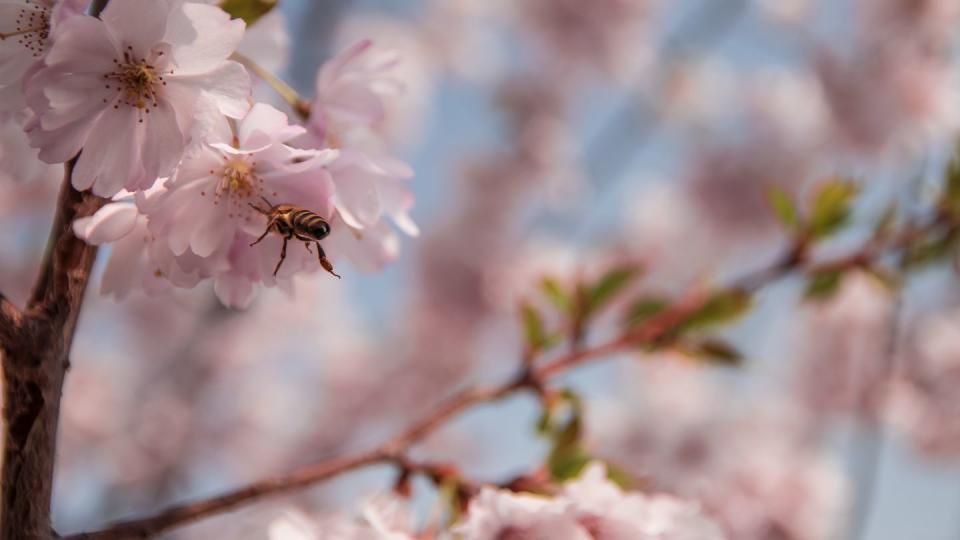
Cutleaf Staghorn Sumac
“From its chartreuse summer leaves come fiery red and orange fall colors accented by the colorful fruit that emerge,” McEnaney says. He recommends Bailey Nurseries’ Tiger Eyes Cutleaf Staghorn Sumac. “It’s one of my favorite multi-season plants that adds so much texture and color to the late-season landscape.” This tree is hardy in USDA zone four, making it less accessible than other plants, but it has a long lifespan of around 40 years and can grow in partial shade.
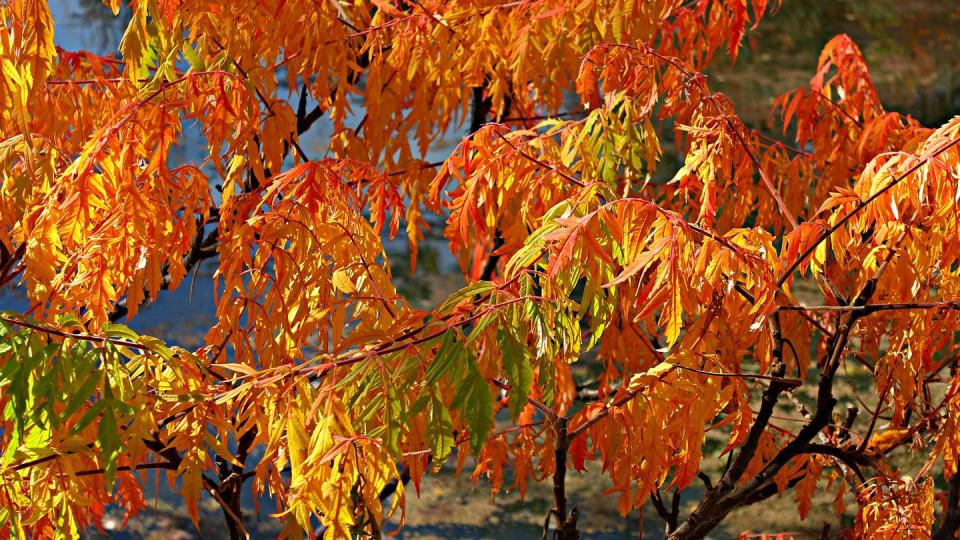
Rose of Sharon (Hibiscus syriacus)
These perennials grow in the fall and can add a pop of color. Choose from pink, purple, white, blue, or red if you want to stick to an autumnal color scheme. These easy-to-grow flowers thrive in USDA zones five to nine, all types of soil, and minimal sunlight. “This is a low-maintenance favorite for those of us who don’t have a green thumb, as it pretty much maintains itself throughout its life,” Wright says. “Rose of Sharon also attracts butterflies and other beneficial pollinators to home gardens. Birds that eat mosquitoes will seek shelter in a Rose of Sharon, helping to eliminate those unwanted pests.”
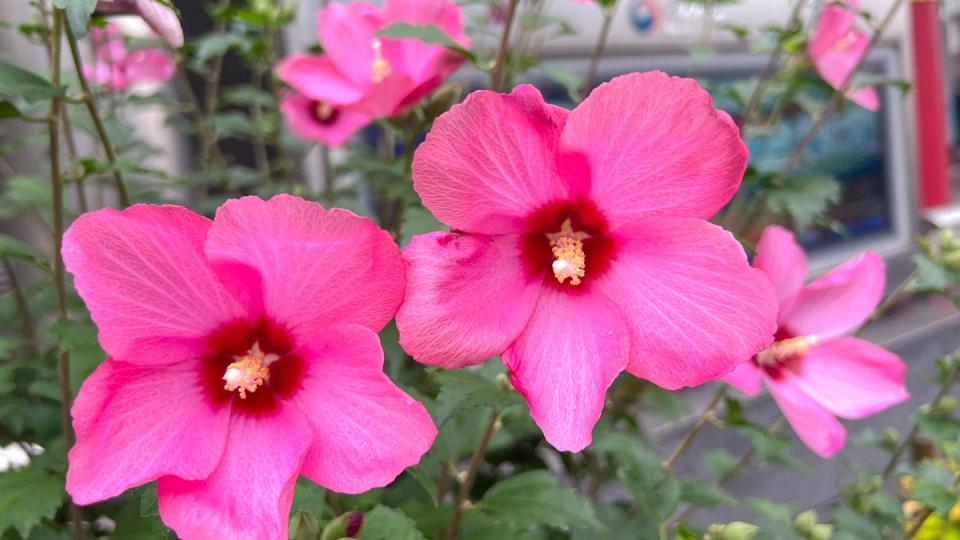
Witch Hazel
Get in the spooky mood for Halloween with this plant’s spider-like flowers. Blooming in October and November, these blooms have yellow petals that appear wiggly like spider legs. Wright says witch hazel plants prefer full sun to partial shade, can adapt to any soil conditions, and consistent watering is the key to success. It thrives in USDA zones three to nine.
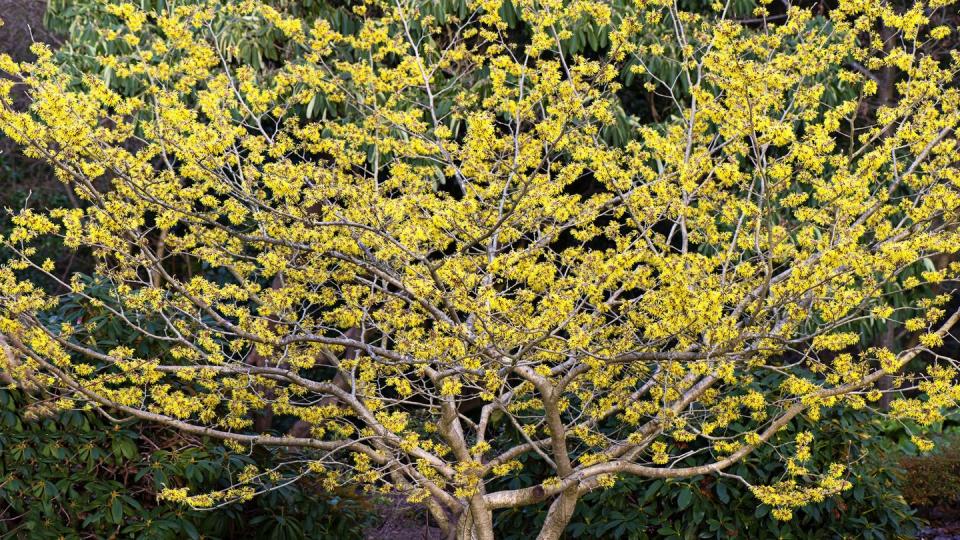
Petunias
These popular blooms provide color through spring and all the way into the first frost, the Farmer’s Almanac notes, making them a popular plant for fall gardens. They can be planted as annuals in most zones, but act as perennials in zones nine through 11. The Farmer’s Almanac recommends planting established plants for your best bet, as seeds are super-small and dust-like, requiring a lot of attention.
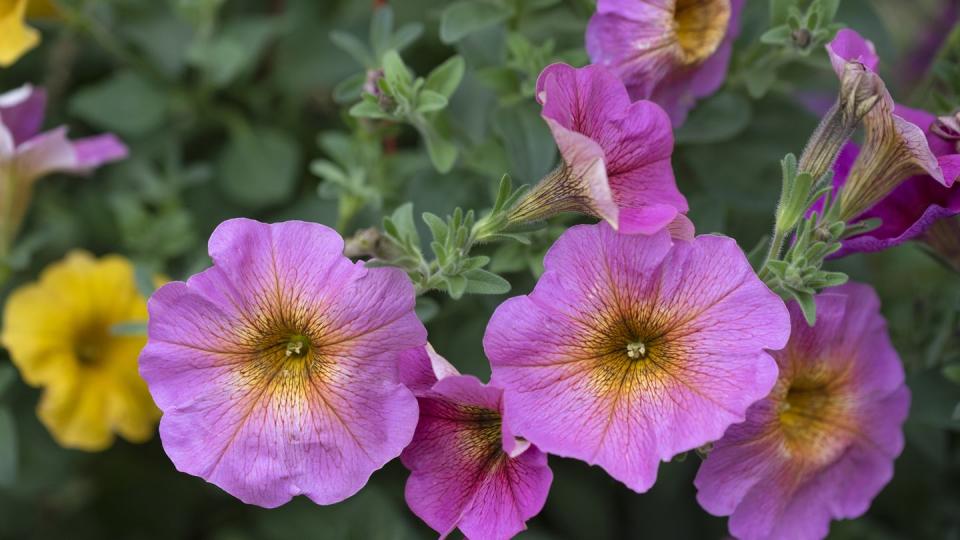
You Might Also Like

